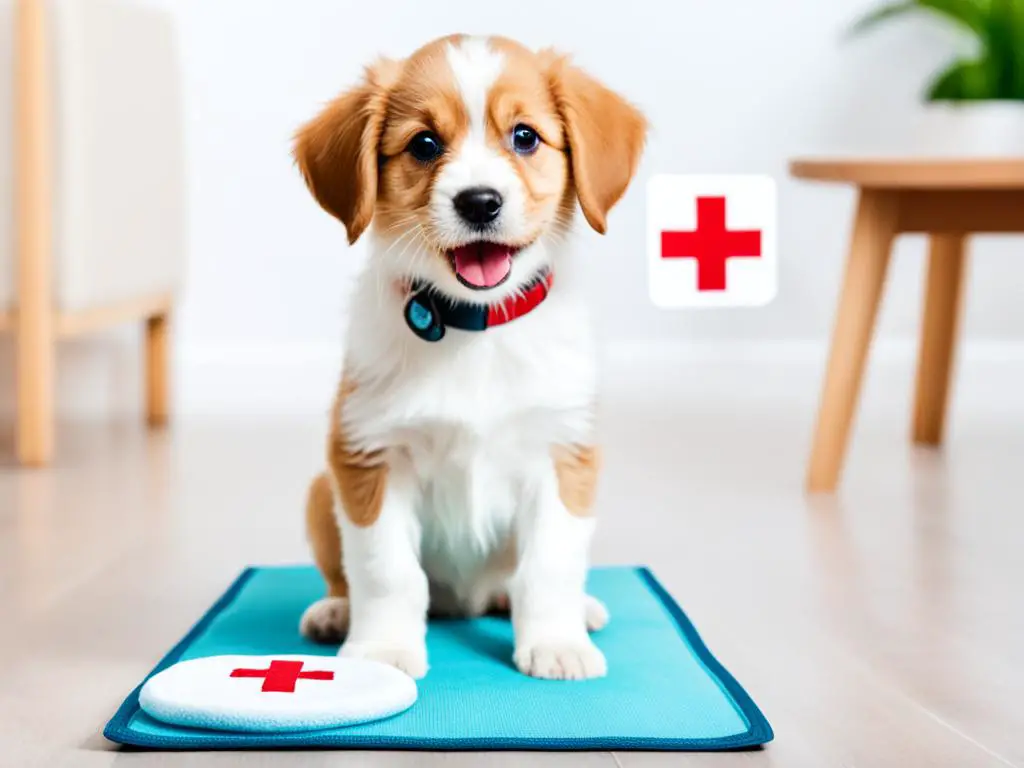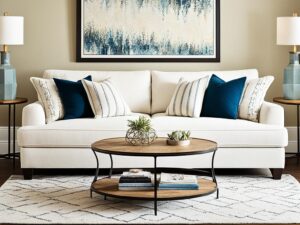Housebreaking your dog is an important part of pet ownership. While accidents are bound to happen, it’s essential to train your puppy to go to the bathroom outside rather than on your rug. Establishing a routine and using positive reinforcement can make this process easier for both you and your furry friend.
When it comes to stopping your puppy from peeing on the rug, consistency is key. By following some simple potty training tips, you can create a clean and comfortable living environment for both you and your pup.
Key Takeaways:
- Establish a routine for regular potty breaks.
- Use positive reinforcement, such as treats and praise, when your puppy goes outside.
- Thoroughly clean any previous accidents to eliminate lingering scent.
- Consider crate training as an effective way to prevent accidents indoors.
- Be patient and persistent during the housebreaking process.
Preventing Puppy Accidents – Effective Housebreaking Techniques
Housebreaking a new puppy is an essential step in ensuring a clean and harmonious living environment. By implementing effective techniques, you can prevent accidents and establish good potty habits. Here are some valuable strategies to help you housebreak your new furry companion and prevent puppy accidents:
Thorough Cleaning
Before you begin the housebreaking process, it’s crucial to thoroughly clean any previous pee spots to eliminate the scent that may attract your puppy. Use pet-friendly cleaners to ensure all traces of urine are removed, making it less likely for your pup to revisit those areas.
Establish a Routine
Setting up a consistent routine is key to successful housebreaking. Take your puppy outside at regular intervals, such as after meals, naps, or play sessions. This routine will help them understand that outdoor space is the designated potty area. Use a leash to guide them to the same spot each time, as familiarity will reinforce the desired behavior.
Reward and Praise
Positive reinforcement plays a crucial role in housebreaking. Whenever your puppy eliminates outside, reward them with treats, praise, or a favorite toy. This positive association encourages them to repeat the behavior and reinforces their understanding of appropriate potty habits.
Recognize Signs of Needing to Relieve
Pay close attention to your puppy’s behavior to recognize signs that they need to relieve themselves. Common indicators include circling, sniffing the ground, or becoming restless. If you notice any of these signs, take your puppy outside immediately to avoid accidents indoors.
“Preventing accidents starts with thorough cleaning to eliminate the scent of previous pee spots that may attract the dog.”
Puppy accidents can be frustrating, but with patience and persistence, you can effectively housebreak your new furry friend. Consistency, routine, and positive reinforcement are key elements in preventing accidents and establishing good potty habits.
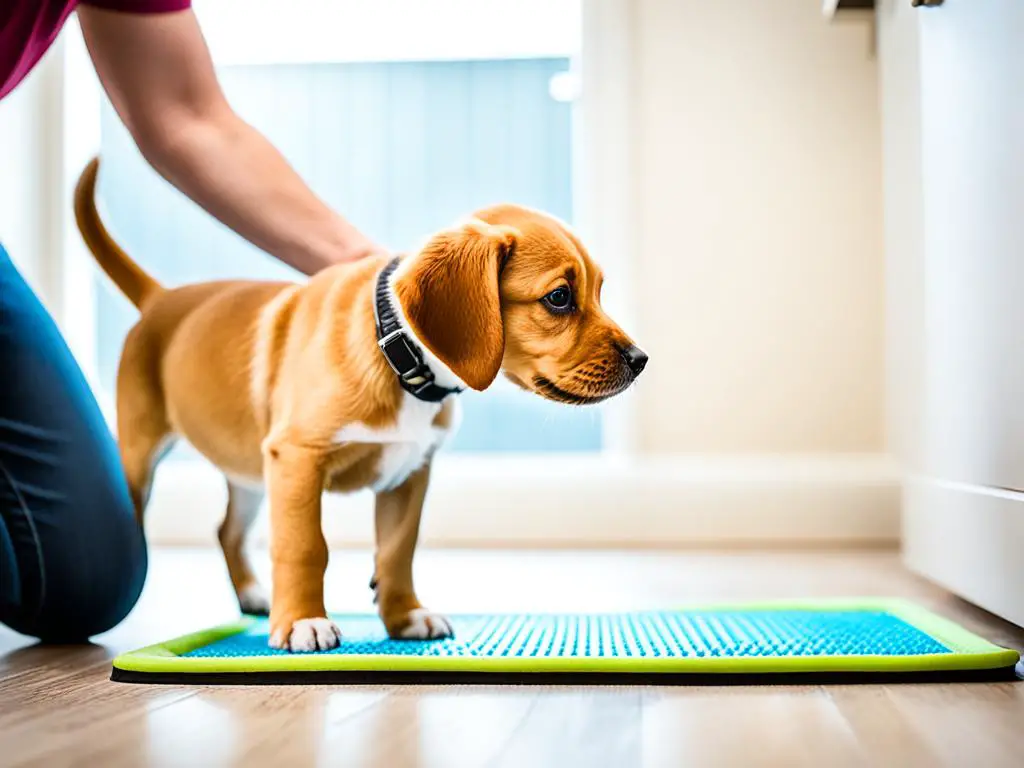
Housebreaking Techniques Checklist
| Technique | Description |
|---|---|
| Thorough Cleaning | Eliminate the scent of previous pee spots to discourage revisiting. |
| Establish a Routine | Take your puppy outside at regular intervals to reinforce outdoor potty habits. |
| Reward and Praise | Use positive reinforcement to encourage appropriate potty behavior. |
| Recognize Signs | Be attentive to your puppy’s cues to avoid accidents indoors. |
Crate Training for Puppies – Creating a Safe Space
Crate training is a valuable tool in the process of housebreaking a puppy. A crate provides a safe and comfortable space for your furry friend and can help prevent accidents by restricting their access to the carpet. Follow these steps to ensure successful crate training for your puppy:
- Choose the right crate: Select a crate that is spacious enough for your puppy to stand, turn around, and lie down comfortably. This will ensure their comfort and make the crate a welcoming space.
- Introduce the crate gradually: Begin by placing treats and toys inside the crate to entice your puppy to go inside. Allow them to explore the crate at their own pace, making sure to provide positive reinforcement whenever they enter or spend time in the crate.
- Create a positive association: Make the crate a positive space by feeding your puppy their meals inside the crate and using treats and toys as rewards. This will help your puppy see the crate as a safe and enjoyable place to be.
- Create a consistent routine: Establish a routine for crate training that includes regular time spent in the crate. Start with short periods and gradually increase the duration. This will help your puppy become accustomed to being in the crate and reduce any anxiety they may feel.
- Use positive reinforcement: Whenever your puppy enters the crate willingly or remains calm inside, provide praise and treats to reinforce their good behavior. This will help them associate the crate with positive experiences and encourage them to view it as their own safe space.
Remember, patience and consistency are key when crate training your puppy. Gradually increase the amount of time your puppy spends in the crate, making sure to provide positive reinforcement and a comfortable environment. Crate training can be an effective tool in housebreaking your puppy and promoting their obedience.
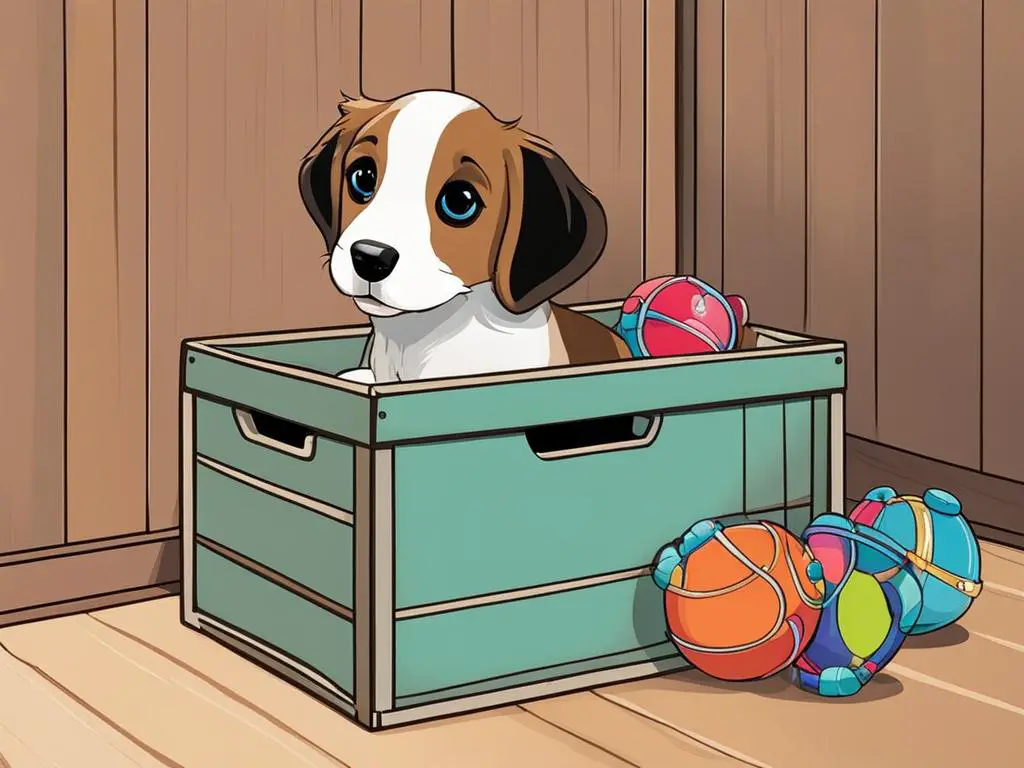
Expert Tip:
“When introducing a crate to your puppy, it’s important to make it a positive experience. Take things slow and always provide rewards and praise for their cooperation. The crate should never be used as a form of punishment, but rather as a safe and secure space for your puppy to relax and feel comfortable.”
Indoor Potty Training for Dogs – Alternative Options
If it’s not possible to take the puppy outside for potty breaks, indoor potty training can be an option. There are several alternative methods that can help teach your puppy to go potty indoors while still reinforcing the desired behavior of eventually going outside. Here are a few options to consider:
Puppy Pads
Using puppy pads is a popular indoor potty training method. These pads are specially designed to absorb urine and control odor. Place the puppy pad in a designated area of your home and encourage your puppy to use it when they need to relieve themselves. It’s important to be consistent and patient during the training process. Gradually decrease the number of puppy pads used as your puppy becomes more accustomed to going outside.
Artificial Grass
Another option is to create an indoor potty area using artificial grass. This provides a more natural surface for your puppy to use. Similar to puppy pads, place the artificial grass in a designated area and encourage your puppy to use it. The textured surface can help mimic the feeling of going potty outside. It’s important to reward and praise your puppy when they use the designated area correctly.
Litter Box
For small dog breeds or puppies that are being trained to use a litter box, this can be an effective indoor potty training option. Use a shallow litter box filled with litter specifically designed for dogs. Introduce your puppy to the litter box and encourage them to use it when they need to go potty. Over time, you can gradually move the litter box closer to the door to transition your puppy to going potty outside.
Remember, consistency is key in any indoor potty training method you choose. It’s important to establish a routine and set clear expectations for your puppy. Reward and praise your puppy when they use the designated area correctly, and be patient during the training process. With time and consistency, your puppy will become accustomed to the desired potty behavior both indoors and outdoors.
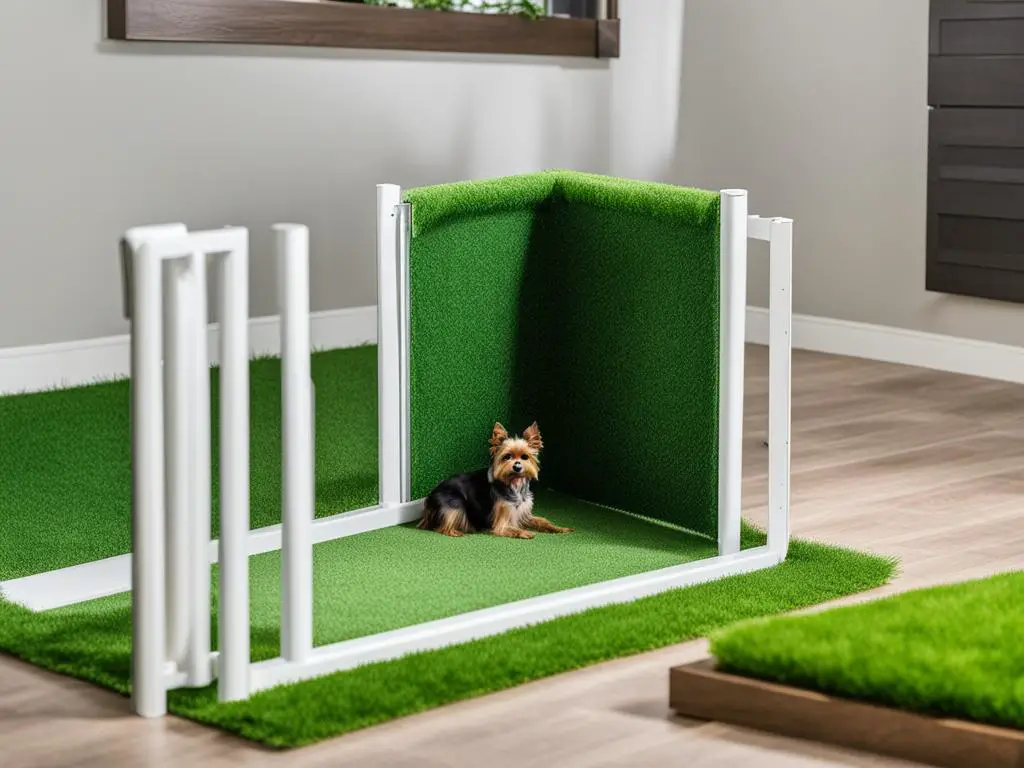
A Sample Indoor Potty Training Schedule
| Time | Activity |
|---|---|
| Morning | Take your puppy to the designated indoor potty area and encourage them to go potty. Reward and praise them when they use the area correctly. |
| Mid-Morning | Repeat the process of taking your puppy to the indoor potty area. Use consistent cues to let them know what you expect them to do. |
| Afternoon | Continue taking your puppy to the indoor potty area. Monitor their behavior closely and look for signs that they need to go potty. |
| Evening | Take your puppy to the indoor potty area one last time before bedtime. Create a calm and relaxed environment to encourage them to go potty. |
Teaching Puppy Toilet Training Techniques
When it comes to toilet training your puppy, there are various techniques that can be effective in helping them learn proper elimination habits. Two popular methods are the Bell Method and the Paper Training Method.
The Bell Method
The Bell Method involves teaching your puppy to ring a bell when they need to go outside. Here’s how you can implement this technique:
- Hang a small bell near the door that leads to the designated potty area.
- Encourage your puppy to interact with the bell by gently nudging it with their nose or paw.
- Every time you take your puppy outside for a potty break, prompt them to ring the bell with their nose or paw before opening the door.
- Once your puppy rings the bell, immediately take them outside to the designated potty area.
- Provide verbal praise and treats when your puppy eliminates in the appropriate spot.
Consistency is crucial in reinforcing this behavior. Over time, your puppy will learn to associate ringing the bell with going outside to eliminate.
The Paper Training Method
The Paper Training Method involves training your puppy to eliminate on newspaper or puppy pads. Here are the steps to follow:
- Choose a specific area in your home where you want your puppy to eliminate.
- Cover the chosen area with newspaper or puppy pads.
- Take your puppy to the designated area regularly, especially after meals or naps.
- Encourage your puppy to eliminate on the newspaper or puppy pads by using verbal cues and praise.
- When your puppy successfully eliminates in the appropriate spot, reward them with treats and affection.
As your puppy becomes more familiar with the designated area, you can gradually reduce the size of the papered area and eventually transition them to outdoor elimination.
Using positive reinforcement and remaining consistent in your training efforts are key to successfully teaching these toilet training techniques to your puppy. Remember to be patient and understanding as your furry friend learns to master proper elimination habits.
Common Reasons for Dogs Peeing on Rugs
Dogs may pee on rugs for various reasons, including their age, lack of potty training, separation anxiety, routine changes, changes in the home environment, or medical issues.
Puppies, in particular, are more likely to have accidents on rugs due to their inability to hold urine for long periods. Dogs that have not been properly potty trained or have unknown histories may also develop a habit of peeing indoors.
Separation anxiety and changes in routine or home environment can also contribute to a dog’s tendency to pee on rugs as they may be experiencing stress or anxiety.
If you have an older dog that suddenly starts peeing indoors, it’s crucial to rule out any underlying medical causes. Infections, bladder stones, or other urinary tract issues could be the reason behind the behavior change.
Age and Potty Training
Young puppies are still developing bladder control and may not have the ability to hold their urine for an extended period. They have small bladders and need to be taken outside frequently. Lack of proper potty training can also lead to accidents on rugs.
Separation Anxiety and Changes in Routine
Dogs that experience separation anxiety may resort to peeing on rugs as a response to stress or the feeling of being left alone. Changes in routine, such as a new work schedule or household dynamics, can also disrupt their potty training habits.
Changes in the Home Environment
Introducing new furniture, moving to a new home, or rearranging the existing layout can confuse dogs and disrupt their usual elimination patterns. They may pee on rugs as a way to mark territory or express their discomfort with the changes.
Medical Issues
If your dog is exhibiting a sudden change in behavior and starts peeing on rugs, it’s essential to consult with a veterinarian. Underlying medical issues, such as urinary tract infections, bladder stones, or kidney problems, could be the cause of the inappropriate elimination.
| Reasons for Dogs Peeing on Rugs | Description |
|---|---|
| Age and Potty Training | Young puppies may not have developed bladder control and require frequent potty breaks. Lack of potty training can contribute to accidents on rugs. |
| Separation Anxiety and Changes in Routine | Dogs experiencing separation anxiety or adjusting to changes in routine may turn to rugs as an outlet for their stress or confusion. |
| Changes in the Home Environment | Introducing new furniture, moving, or rearranging the home can disrupt a dog’s elimination habits, leading to accidents on rugs. |
| Medical Issues | Underlying medical conditions, such as urinary tract infections or bladder stones, can cause dogs to pee on rugs. It’s essential to consult with a veterinarian if sudden changes occur. |
How to Prevent Your Dog from Peeing on the Carpet
To prevent your dog from peeing on the carpet, it’s important to train or retrain them to use appropriate areas for elimination. Take your dog outside regularly, provide potty breaks, and closely monitor their behavior to catch any signs of needing to go. Using carpet sprays or special repellants can help discourage dogs from peeing on the carpet. Vinegar, lemon juice, and alcohol can be effective natural repellants. However, if the behavior persists, or if there are any medical concerns, it’s best to seek help from a veterinarian.
Training Tips to Prevent Accidents
- Establish a consistent routine for potty breaks and stick to it.
- Designate specific areas outside for your dog to eliminate and guide them to those spots.
- Use positive reinforcement, such as treats and praise, when your dog eliminates in the appropriate area.
- Keep a close eye on your dog’s behavior and take them outside immediately if they show signs of needing to go.
Consistency is key when it comes to preventing your dog from peeing on the carpet. By providing regular potty breaks and reinforcing positive behavior, you can help your dog understand where it’s appropriate to eliminate.
Using carpet sprays or special repellants can also be helpful in deterring your dog from peeing on the carpet. These products can be sprayed directly on the carpet to create an unpleasant scent or taste that discourages your dog from urinating in that area. Additionally, natural repellants like vinegar, lemon juice, and alcohol can be effective alternatives to commercial sprays. Just be sure to test these substances on a small, inconspicuous area of your carpet first to ensure they won’t cause any damage.
If despite your efforts, your dog continues to have accidents on the carpet, it may be a good idea to consult with a veterinarian. They can help rule out any underlying medical issues that may be contributing to the problem. A vet can also provide guidance on behavior modification techniques or suggest additional strategies to prevent your dog from peeing on the carpet.
| Preventive Measures | Effectiveness |
|---|---|
| Establishing a consistent routine | Highly effective |
| Using carpet sprays or repellants | Moderately effective |
| Natural repellants like vinegar, lemon juice, and alcohol | Varies depending on the dog |
| Consulting with a veterinarian | Highly recommended |
Conclusion
Housebreaking a new puppy and preventing them from peeing on the rug requires consistency, positive reinforcement, and understanding their behavior. By following these puppy potty training tips, you can create a clean and comfortable environment for both you and your pet.
Start by establishing a routine for regular potty breaks and stick to it. Consistency is key in teaching your puppy where and when to go. Use crate training for puppies as a safe space and a tool to prevent accidents. Gradually increase the time they spend in the crate and reward them for good behavior.
If you’re unable to take your puppy outside for potty breaks, consider indoor potty training for dogs. Set up a designated area with puppy pads or artificial grass and be consistent in using it. Reward your puppy for using the designated area correctly and gradually transition them to go outside.
Remember, puppy obedience training is essential for teaching basic commands and preventing unwanted behaviors. Address any medical concerns that may be causing accidents by consulting with a veterinarian. With patience and persistence, you can successfully housebreak your new puppy and enjoy a clean, well-trained pet.
